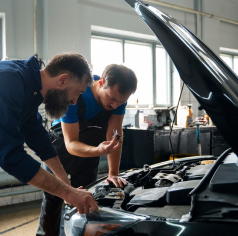How to Prepare Your Vehicle for a Long Road Trip

How to Prepare Your Vehicle for a Long Road Trip
Planning a long road trip can be exciting, but before hitting the open road, it’s essential to ensure your vehicle is ready for the journey. Proper preparation not only enhances your comfort but also ensures safety and reliability. Here’s a checklist to help you get your vehicle ready for an adventure.
1. Check Fluid Levels
Start by checking all essential fluids, including:
- Engine Oil: Ensure it’s at the proper level and clean.
- Coolant: Check the radiator and overflow tank; top up if necessary.
- Brake Fluid: Ensure it’s at the recommended level for safe braking.
- Transmission Fluid: Inspect and replace if it appears dark or burnt.
- Windshield Washer Fluid: Fill up to ensure clear visibility.
2. Inspect Tires
Proper tire maintenance is crucial for a safe trip:
- Tire Pressure: Check all tires, including the spare, and inflate to the recommended PSI.
- Tread Depth: Ensure there’s enough tread to provide traction, especially if driving in varying weather conditions.
- Alignment and Balancing: If you notice uneven wear or the vehicle pulls to one side, consider getting an alignment.
3. Examine the Battery
A healthy battery is vital for a smooth trip:
- Connections: Check for corrosion and ensure terminals are tight.
- Charge: If your battery is more than three years old, consider having it tested.
4. Inspect Brakes
Ensure your brakes are in top condition:
- Pads and Rotors: Listen for squeaking or grinding noises and check for wear.
- Brake Fluid: Confirm it’s at the correct level.
5. Test the Lights
Make sure all lights are functioning properly:
- Headlights, Taillights, and Turn Signals: Check and replace any burnt-out bulbs.
- Brake Lights: Have someone help you check these while you press the brake pedal.
6. Clean and Organize the Interior
A tidy vehicle enhances comfort during long drives:
- Remove Clutter: Clear out unnecessary items to maximize space.
- Clean Surfaces: Wipe down the dashboard and other surfaces for a more pleasant environment.
7. Pack an Emergency Kit
Prepare for the unexpected:
- Essentials: Include a first aid kit, flashlight, extra batteries, water, and non-perishable snacks.
- Tools: Pack basic tools, jumper cables, and a tire repair kit.
8. Plan Your Route
Having a plan can reduce stress:
- Navigation: Use GPS or maps to plan your route. Consider downloading offline maps in case of poor signal areas.
- Stops: Identify rest stops, gas stations, and attractions along the way for breaks.
9. Check Your Air Conditioning and Heating
Ensure climate control systems are functioning well:
- A/C Performance: Test the air conditioning for effective cooling, especially in warmer climates.
- Heating: Make sure the heating system works for colder weather.
10. Schedule a Pre-Trip Inspection
If you’re unsure about your vehicle’s condition, consider scheduling a professional inspection:
- Mechanic’s Check: A thorough inspection can identify potential issues before they become problems.

